
Fascinated by ancient ruins and how human civilizations began, Chuck Spencer decided to become an archaeologist. Find out why patience, perseverance, and imagination are key to studying people who lived long ago.
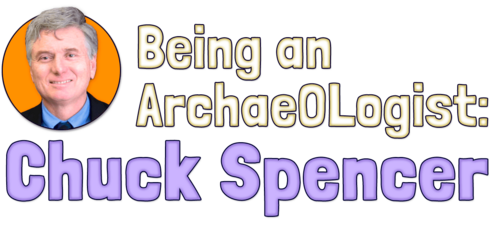
Fascinated by ancient ruins and how human civilizations began, Chuck Spencer decided to become an archaeologist. Find out why patience, perseverance, and imagination are key to studying people who lived long ago.
1. What is archaeology?
Chuck Spencer: Archaeology is the study of how people lived in the past. Archaeologists examine the buildings, artifacts, settlements, and even the bones that people left behind. These clues help us put together a picture of what life was like a long time ago.
For example, I study the ancient Zapotec people who lived more than 2,000 years ago in Oaxaca, Mexico. I am interested in how the Zapotecs created one of the earliest civilizations in Mexico.
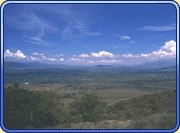
The Valley of Oaxaca, Mexico.
2. How did you become interested in archaeology?
Chuck: I grew up in Panama, where my father worked for the Panama Canal. I was always interested in the old ruins, the Spanish forts, and archaeological sites. I remember really enjoying a museum in Panama that had archaeological exhibits. I also always liked history and science in school.
One summer during college, I volunteered on an archaeological project in Oaxaca, Mexico , with one of my professors. I helped make a map of the site of Monte Alban. That summer was a real turning point for me. After college I spent two years working as an archaeological field assistant in Oaxaca, where I learned more about the people and their ancient cultures. Then I went to graduate school and got my Ph.D. so that I could have a career as an archaeologist.
Twenty years later, I'm still fascinated by archaeology in Oaxaca.
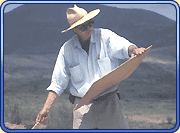
Chuck draws part of a palace found in Oaxaca, Mexico.
3. Did anyone inspire you to become an archaeologist?
Chuck: I took one course in college with a famous anthropologist. It was a very powerful experience. The professor explained how history could be studied from a scientific point of view, and I got really taken by that.
I became interested in how civilizations began and why people live under the political authority of other people. These early governments existed long before written records were kept, so the only way to answer these questions is to do archaeology.
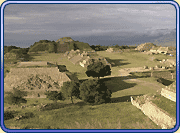
This is the city of Monte Alban, the capital of the Zapotec state .
4. What does it take to be an archaeologist?
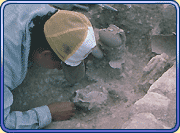
Excavation requires detailed work and a lot of patience!
Chuck: Being an archaeologist combines a lot of different skills. First of all, it takes persistence because a lot of the work in archaeology is very slow. You might be out excavating ancient houses or temples. It sounds very glamorous, but you are digging up thousands of little pieces of pottery, stone, bone, and other objects. You have to record and draw everything, and then study each artifact carefully. It can be very hard work.
I think it also helps if you are the type of person who enjoys using the scientific skills of collecting and classifying data. In archaeology, this usually means counting and organizing objects into categories so that you can analyze them.
It also takes imagination. You have to try to put yourself in the position of people who lived long ago, to project yourself back in time . You almost have to come up with a movie in your head of what could have happened to leave behind the remains you are excavating. You have to empathize with people who lived long ago that you will never meet. Sometimes, people who still live in the area can provide valuable clues about the history of the remains.
5. What's an archaeological site?
Chuck: A site is simply an ancient settlement or what's left of an ancient settlement. Sometimes we don't excavate every archaeological site we find, but we do surveys to record the locations of all the archaeological sites in a particular place. In the Valley of Oaxaca, where I work, we only excavated a few areas of the site because we want to leave evidence for future archaeologists to find.
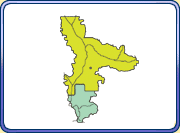
A map of Oaxaca, Mexico. The dot marks the site of Chuck's excavation.
6. How do you find a site to excavate?
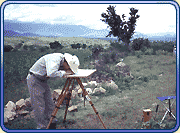
Chuck makes a map to help him find the best place to dig.
Chuck: I often begin by walking over an area with a team of archaeologists. I try to figure out how big a site is by examining clues lying above ground. Sometimes I'll see bits and pieces of stone foundations poking through, or I'll find pieces of pottery scattered around. In my work in Mexico, we often find earthen mounds that are the remains of old pyramids. It can also be helpful to look at aerial photographs of the area.
With all this information, we make a map of the entire site. Then we can decide exactly where we might excavate. The place we excavate is the dig, which is only a tiny part of the whole archaeological site.
7. Why do you only dig a small part of a site?
Chuck: Excavation is very expensive and slow. It can take years of field seasons to excavate a small percentage of the whole site.
It's also important to leave things for future archaeologists to find who might have better techniques for finding and analyzing evidence than we have now. You want to give future archaeologists a chance to make new discoveries.
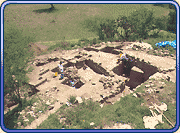
It took several years to excavate the remains of this house.
8. Who is part of your crew?
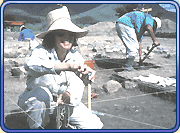
Elsa in the field.
Chuck: I always co-direct the projects with my wife Elsa Redmond, who is also an archaeologist. She and I have been working together since we were in college.
We usually take four or five graduate students with us to work as excavation team supervisors, and then we hire about 30 workmen who live in the nearby village to do a lot of the actual excavation. Of course, we don't begin working at a site until we've gotten permission from the government, the state, and the town where we want to excavate.
9. What's a typical day like on a dig?
Chuck: We usually get up before dawn and have breakfast. Then we drive to the town in our truck and pick up some of the workmen who need a ride. We keep all our tools in a tent at the site so that we don't have to bring them every day. We divide into teams and start to dig at about 8 a.m.
We usually have about six different operations going on at the same time in different areas. For example, each team of workmen will be excavating in a different area. A graduate student will be mapping where all the objects were found, and making sure everything is bagged and tagged. They also will be keeping a field journal , recording everything that happens in their area, and taking lots of measurements, such as how deep we dig. I'm often taking photographs and consulting with the various excavation teams.
So we'll work like that until lunchtime. After we eat, we dig again until about 4 p.m. Then we take everything we find to the lab and drive home. We are often really exhausted, so we relax and get ready for the next day.
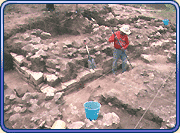
The crew puts in a lot of work to remove the rubble covering this wall.
10. What's in your tool kit?
Chuck: A lot of stuff!
- wheelbarrows
- shovels
- picks
- trowels
- screwdrivers
- small ice picks for finer digging
- whisk brooms
- paintbrushes
- sugar scoops for scooping up dirt and putting the dirt into buckets
- lots of plastic buckets
- screens with wooden sides that we put the dirt in and shake back and forth to get little artifacts you might miss when you're digging up dirt
- measuring tapes
- plywood boards with graph paper for drawing
- toolboxes for all our small tools like dental picks
- balls of string and eight-inch nails for setting up our grid system
- hundreds of meters of plastic sheeting to cover up exposed areas when it rains
- two cameras with interchangeable lenses for recording everything we find
- a video camera to document what we've found
- and much more!
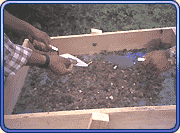
The sieve and trowels are useful in finding small pieces of artifacts.
11. How do you photograph your dig site?
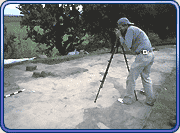
Chuck takes photographs to record the entire excavation process.
Chuck: I'm the photographer. I take constant photographs of the work as dirt is removed and things are exposed. That's a very big job since every single thing we excavate has to be photographed in place before we remove it from the ground.
One of the most important clues we have is where an object was found. Later, in the lab, when we're far away from the site, we look at the photographs over and over to remind us where we found an object. We take hundreds and hundreds of photographs every field season, both in color and black and white. I also take videos documenting what we've found.
12. When you find an artifact, how do you decide what it is or how it was used?
Chuck: We often know what an artifact is because we recognize it as something we have seen or read about before. For example, we find a lot of broken pottery in Oaxaca. When we pick up a tiny little piece, we know what kind of vessel it came from. After all these years of digging in Oaxaca, we are very familiar with different pottery types. So it's not too hard to figure it out.
If we don't know what something is immediately, we look at where it was found and at the other objects that were found with it. We ask a lot of questions about an object and study it carefully. We also do research about the other digs in that area so that we can compare the artifact to other similar artifacts.
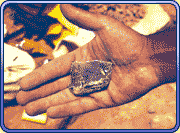
A tiny piece of pottery holds many clues, like what kind of pot it came from and the age of the site.
13. How do you keep track of everything you find?
Chuck: Before we begin excavating, we create a grid with string to divide the site into small units. Each unit is called a provenience. As we excavate, we collect all the objects for each provenience in bags. All the things that are the same are bagged together. For example, pottery might go in one bag, shell in another bag, and bone in a third bag.
We write a card for each provenience, and each gets its own catalog number. We record a lot of detailed information for each provenience, like its size, exact location, and how many bags of artifacts we recovered in it. Then we take everything back to the lab, where we can study it more carefully and compare it to other things we found at the site.
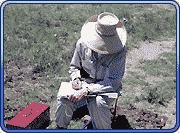
An archaeologist records information on artifacts found together in a provenience.
14. What's the most exciting thing you've ever excavated?
Chuck: The palace that we just excavated in Oaxaca was really exciting. The palace was the royal home for a king and his family, and it also had a court and an area that was used for ceremonies.
The palace supports the idea that the site was the capital of an ancient society. It was so large that the king and his family couldn't have built it themselves. He would have needed large work groups to construct it. Only a king could organize the kind of labor needed to build a palace. So this is one kind of evidence that a state society existed in Oaxaca as early as 300 B.C.. It's also important because it is the earliest palace so far discovered in the wide area called Mesoamerica, which includes Mexico, Guatemala , El Salvador, Honduras, and Belize.
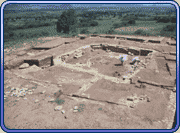
The palace in Oaxaca, Mexico.
15. What's the most interesting artifact you've found?
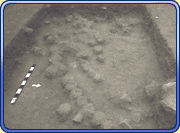
The remains of a skull rack that toppled over.
Chuck: Several years ago we discovered a toppled-over skull rack in Oaxaca, in one of the communities that had been conquered around 300 B.C.. The heads of people who resisted the invasion were probably placed on the rack by the conquerors as a symbol of terror.
Archaeologists knew that in the 1500s the Aztecs had a skull rack in their capital, but no one realized that people were doing the same thing more than 1,500 years earlier.
16. What happens to the artifacts you find?
Chuck: Almost all of what we find stays in Mexico at the National Institute of Anthropology and History. Most of the objects go into storage. We have set up a small display in the town hall where we are working so that the local people can see some of the interesting artifacts we've discovered.
Some objects are difficult to analyze in Mexico, so we bring them back to the lab at the American Museum of Natural History to analyze them with our high-tech lab equipment. We get permission from the government before we remove anything. Most of what we bring back to the United States are our observations of the data, the photographs, the maps, the drawings of architectural and other features, and the coding sheets that tell us how many of each type of thing we found.

Archaeologists analyze artifacts in a lab in Oaxaca.
17. Why does the Museum keep a collection of thousands of artifacts collected by archaeologists so many years ago?
Chuck: We have many large and important collections of artifacts from Latin America. They were brought here by archaeologists who conducted research many years ago and helped establish a basic understanding of ancient cultures like the Aztec, the Zapotec, and the Inca.
People come here from all over the world to study our collection. We also use the artifacts to train students in some of the basic techniques of archaeology before they do fieldwork. We have high school and college students, graduate students, and visiting scholars who have worked on the collection. I supervise all the work that gets done on the collection. It's exciting to have so many people interested in what we have here.
The collection provides an important window into the past, but we no longer collect archaeological artifacts. Instead, we contribute to the preservation of the artifacts in the countries where they are found.
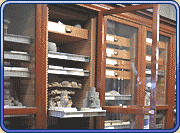
The museum has thousands of artifacts in its collection.
18. When you're not in the field or in the lab in Mexico, what do you do?
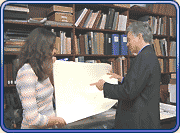
Back at the museum, Chuck discusses field results with a team member.
Chuck: Much of an archaeologist's work is not in the field or the lab because of the other responsibilities we have—whether it is to our jobs or our families. I usually spend two to three months a year in the field. I have a lot of flexibility about when I actually dig, but I have to consider my family's schedule as well as other factors like when the weather is best to dig in Mexico.
The rest of the time, I work on publications about our findings, I write grants to get the money to do research, and I work on educational programs to get people excited about archaeology. Right now I'm the Chair of the Division of Anthropology, so I also do administrative work.
Image Credits:
Photos: Chuck Spencer: courtesy of AMNH; Oaxaca, Mexico: courtesy of AMNH; Chuck in the field: courtesy of Christina Elson; Monte Alban: courtesy of Chuck Spencer; excavation site: courtesy of Christina Elson; Chuck surveying a site: courtesy of Christina Elson; Elsa Redmond: courtesy Chuck Spencer; excavation site: courtesy of Chuck Spencer; sieve and trowels: courtesy of Chuck Spencer; Chuck in the field: courtesy of Christina Elson; piece of pottery: courtesy of Chuck Spencer; archaeologist recording in the field: courtesy of Chuck Spencer; excavation site: courtesy of Chuck Spencer; skull rack: courtesy of Chuck Spencer; archaeologists working: courtesy of Chuck Spencer; Museum collections: courtesy of AMNH; Chuck Spencer and Christina Elson: courtesy of AMNH; Illustrations: Map of Oaxaca Mexico: courtesy of Christina Elson; Tools: Eric Hamilton




 Biodiversity
Biodiversity
 Brain
Brain
 Genetics
Genetics
 Marine BiOLogy
Marine BiOLogy
 MicrobiOLogy
MicrobiOLogy
 PaleontOLogy
PaleontOLogy
 ZoOLogy
ZoOLogy
 AnthropOLogy
AnthropOLogy
 ArchaeOLogy
ArchaeOLogy
 Astronomy
Astronomy
 Climate Change
Climate Change
 Earth
Earth
 Physics
Physics
 Water
Water
